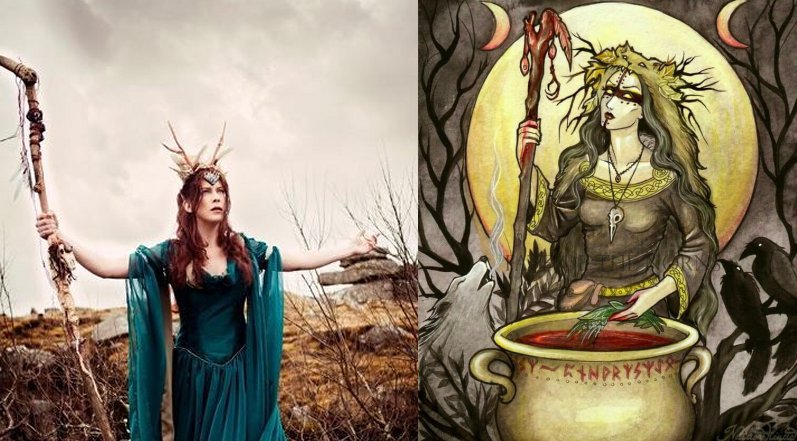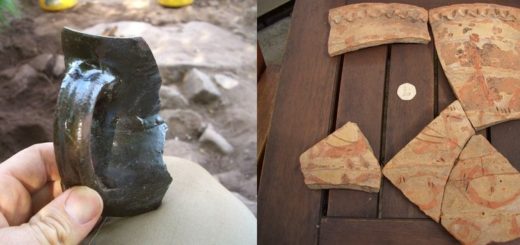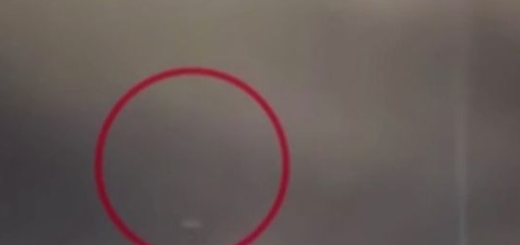Norse Shamanism: A Völva And Her Prophecies Were Feared Among Norse Gods And Vikings
– The Völva was a very powerful female shaman and seer in Norse mythology.
She held a significant place in the ancient Viking society and her powers were considered so strong that not only Vikings feared her prophecies, but even Odin, the greatest of all Norse gods consulted her to learn what the future had in store for the gods.

In Völuspa, Odin offered the völva his necklace and rings as payment for telling him the future. She foretold the creation of the world, the first gods, first people and Ragnarök – the end of the world.
The Völva was considered a Seiðr (sometimes anglicized as seidhr, seidh, seidr, seithr, seith, or seid) is an Old Norse term for a type of sorcery which was practiced in Norse society during the Late Scandinavian Iron Age. The Norns, who were shapers of destiny and recorded days in a person’s life, according to Norse mythology were the foremost masters of seidr.
A Seiðr could not only foretell the future, raise storms, journey or battle in animal form, send a nightmare to kill someone by suffocation in his sleep, and cast love spells.
In his book, Viking Way: Religion and War in Late Iron Age Scandinavia, archaeologist Neil Price writes: “There were seiðr rituals for divination and clairvoyance; for seeking out the hidden, both in the secrets of the mind and in physical locations; for healing the sick; for bringing good luck; for controlling the weather; for calling game animals and fish.
Importantly, it could also be used for the opposite of these things – to curse an individual or an enterprise; to blight the land and make it barren; to induce illness; to tell false futures and thus to set their recipients on a road to disaster; to injure, maim and kill, in domestic disputes and especially in battle.”
The name Völva (vǫlva) is Old Norse and means “wand carrier” or “carrier of a magic staff”. In Norse Sagas, a völva is often described as an old woman who appears late at night. She is dressed in a dark foot-length cloak and in her hand she holds a magical staff.
In some Norse myths and sagas it is written that the wand she held had the power of causing forgetfulness in anyone who is tapped three times on the cheek with it.
The art of prophecy was a divine gift that the Norse goddess Freya taught Odin and the Aesir, Norse gods who were associated with war, magic and the sky.
In Norse mythology, Freya is a powerful goddess. She belongs to belongs to a group of Gods and Goddesses known as the Vanir who were associated with nature, wild places and animals and unseen realms. She is considered to be the goddess of Love and Beauty, but is also a warrior goddess and one of great wisdom and magic. Freya who always had a wand in her hand was the most prominent völva of all.
The völva wandered from town to town and farm to farm performing commissioned acts of magic in exchange for room, board, and often other forms of compensation as well. The most detailed account of such a woman and her craft comes from The Saga of Erik the Red in which a Völva comes to one of the settlements in Greenland to prophesy for the community.
Archaeologists have discovered ancient artifacts that might very well be a wands carried by the Norse female shamans.
The finest ancient rod is at the Historical Museum in Sweden. It comes from a Viking woman’s grave on Öland. It is made of iron with details in bronze. The rod is about one meter long and interrupted at one end. The top is crowned by a house in miniature. Perhaps it is a symbol of Freya’s house “Folkvang”. In the tomb there were also other items that showed that the dead woman had a special status. Maybe the deceased woman was a völva.
A völva needed the magical staff to foretell the future. While excavating some ancient graves in Scandinavia, scientists have also discovered traces of cannabis and other drugs that were most likely used during the rituals.
A völva was just as respected as much as her prophecies were feared. Like many other shamans in ancient cultures, the Norse völva was set apart from her wider society, both in a positive and a negative sense.
Written by Ellen Lloyd – AncientPages.com
Copyright © AncientPages.com & Ellen Lloyd All rights reserved. This material may not be published, broadcast, rewritten or redistributed in whole or part without the express written permission of AncientPages.com and Ellen Lloyd
About the author:Ellen Lloyd – is the owner of AncientPages.com and an author who has spent decades researching ancient mysteries, myths, legends and sacred texts, but she is also very interested in astronomy, astrobiology and science in general



 Creators of mankind
Creators of mankind Description of “Tall white aliens”
Description of “Tall white aliens” Where they came from?
Where they came from? About hostile civilizations
About hostile civilizations The war for the Earth
The war for the Earth “Tall white aliens” about eternal life
“Tall white aliens” about eternal life Video: “Nordic aliens”
Video: “Nordic aliens” Aliens
Aliens Alien encounters
Alien encounters The aliens base
The aliens base UFO
UFO Technology UFO
Technology UFO Underground civilization
Underground civilization Ancient alien artifacts
Ancient alien artifacts Military and UFO
Military and UFO Mysteries and hypotheses
Mysteries and hypotheses Scientific facts
Scientific facts


















